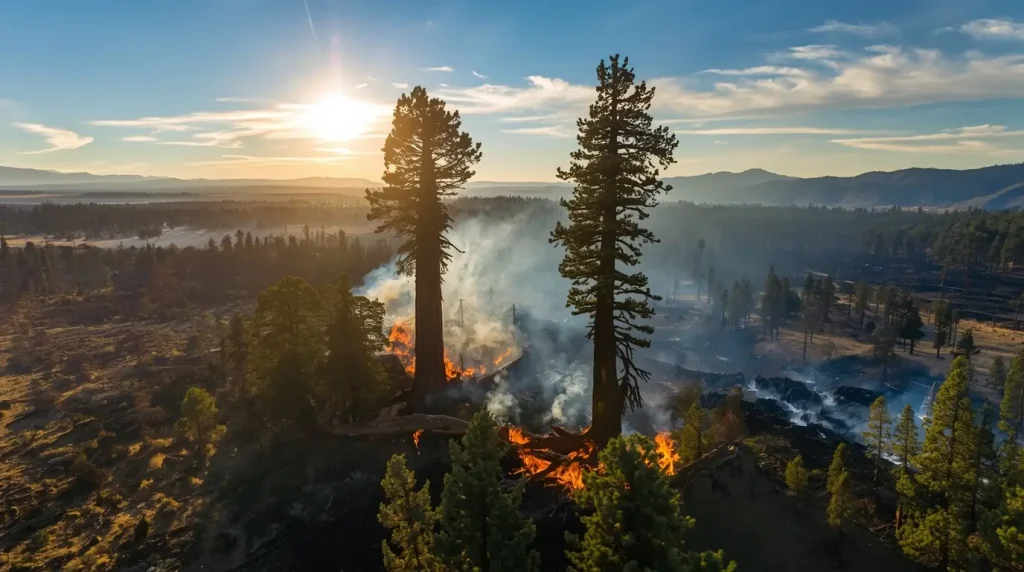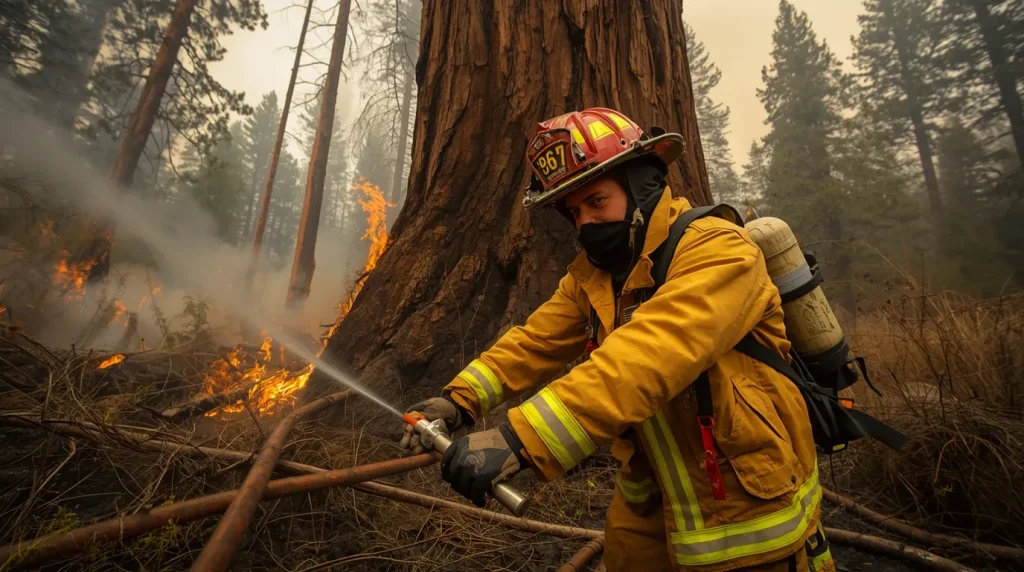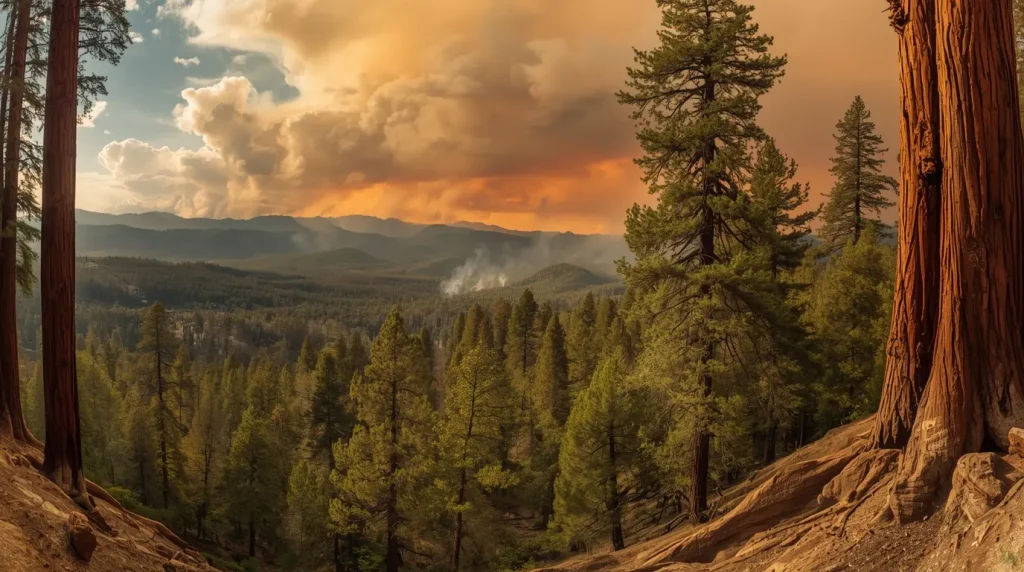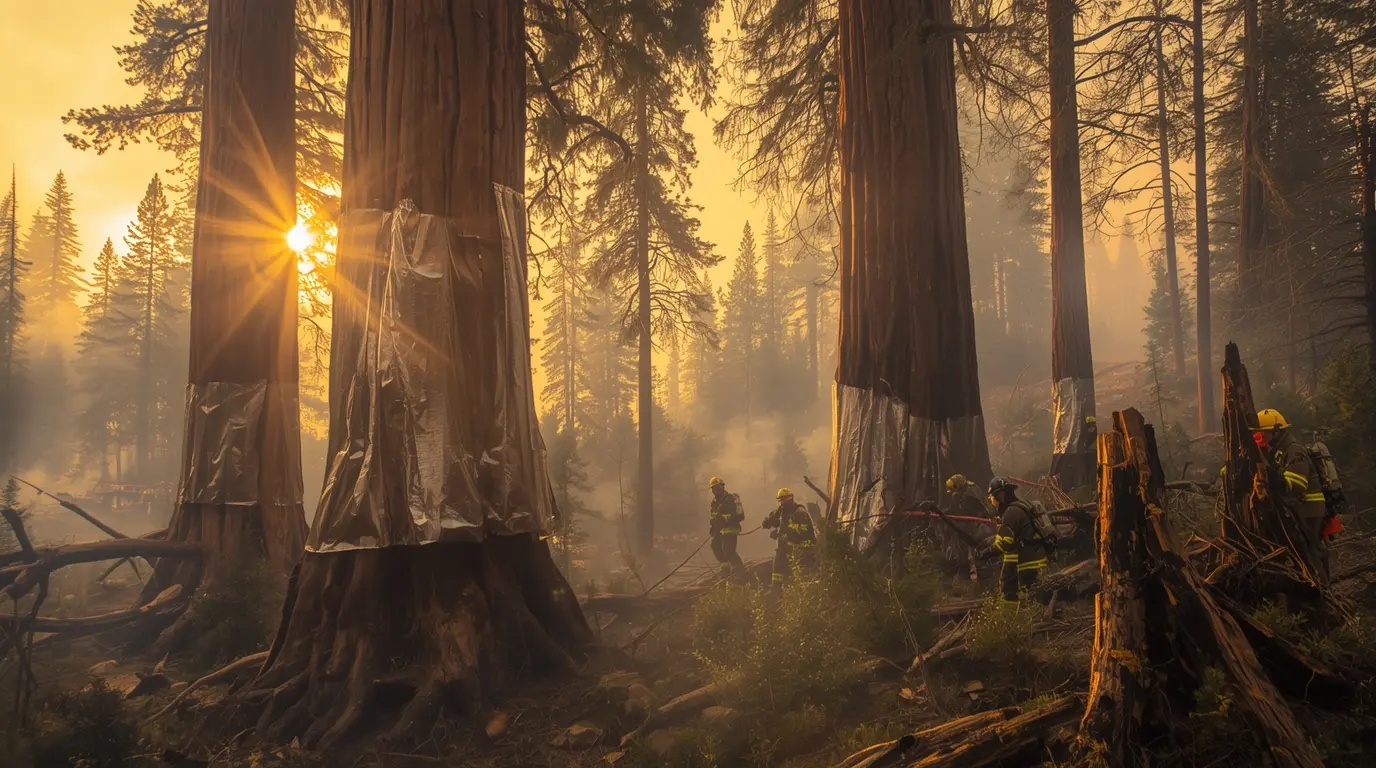California’s Gem Under Siege: When Sequoia Meets Flame
Hidden high in California’s Sierra National Forest, a battle rages between flames and firefighters. On August 24, 2025, a single bolt of lightning sparked what we now call the Garnet Fire. Today, it eats its way toward the heart of McKinley Grove—a 100-acre cathedral of ancient giant sequoias, most over a thousand years old and some many centuries older. That grove is just the latest crown jewel in the Sierra facing the heartbreak of runaway wildfire.
Crew commanders tell us the fire charged past the southeast edge of McKinley Grove between Sunday night and Monday dawn, a fast-moving enemy approaching trees that have weathered earthquakes, floods, and thousands of lightning strikes. Rising temperatures, dead trees from bark beetle invasions, and short winters now conspire to make every wildfire far more intense. The incident is more than a nightmarish headline; it’s California’s blunt reminder that fire, the oldest force on Earth, is now playing a different game.
The Majesty of Sierra National Forest’s Sequoia Groves
Deep within Sierra National Forest lies one of nature’s grandest displays: the sequoia groves. These massive giants stretch across a 260-mile ribbon of the Sierra Nevada’s western slopes, the only place on Earth you’ll find them. Some soar more than 300 feet skyward, making them the largest trees on Earth by volume. Related yet distinct, the nearby coastal redwood has the title of tallest tree, but the sequoia still boasts the most wood within a single trunk.

Jay Tracy, a spokesperson for the Garnet Fire, describes the sequoias as being “near and dear to the forest and to our community.” Many of these ancient sentinels are believed to be upwards of 3,000 years old. They’ve endured thousands of fires, floods, and droughts, surviving each with inner strength. The Sierra National Forest provides the right mix of high elevation, granite soil, and unique weather to keep them growing, making every step we take to protect these groves a step toward guarding an irreplaceable part of our Earth’s history.
Extraordinary Measures to Protect Natural Treasures
Fire crews are using advanced techniques to defend centuries-old giants in Sierra National Forest. Wildland firefighters who specialize in tree climbing scale the trunks to douse flaming crowns—an operation both risky and precise. These actions show how much the nation values the massive living wonders that have sheltered the landscape for millennia.
To shield the sequoias, forward-thinking crews have set in motion a suite of protective tactics:
- Sprinkler lines send a fine mist into the air, raising humidity around the groves.
- Thick, metal-lined blankets wrap the trunks, reflecting heat and smoke.
- Rakes clear away dry needles, cones, and other fuels at the tree bases.
- Fire engines and patrols cruise forest roads, hunting for glowing coals that could flare up.
Seen together, these detailed steps show the teams’ unwavering dedication to keep the Sierra’s living monuments standing for generations to come.

The Complex Role of Fire in Sequoia Ecosystems
The truth is these giants have learned to dance with fire. Their tough, heat-resistant cones open only under flame, showering seeds onto a cleansed forest floor. New sprouts crave the light once shaded shrubs and shrubs have turned into fine fuels. Yet the Garnet Fire burns hotter and fiercer than the gentle cleansers sequoias are used to. Heat this strong can seal off cones and bake the forest in a way the trees could never expect, turning a natural partner into a possible enemy.
The even brighter flames we’re seeing in spots like Sierra National Forest show just how quickly things are changing in the Sierra Nevada. Here in the Sierra, the new normal is hotter, more intense autumn blazes. Thanks to climate change, Californians are learning the map is redder and the burn less predictable than any record we once relied on.
Sierra National Forest isn’t standing alone. It’s square in a nationwide puzzle of drought, heat, and growing fires. For more than two decades, the Sierra Nevada Conservancy has been a steady hand, pouring funding into grants, community partnerships, and scientifically driven restoration projects. Almost a fifth of the state’s forests lie here, so the forest’s health is still the center of any state-level forest vision.
Scientists are reinforcing the point. Emily Moran, a lead researcher at UC Merced, has tracked a counterintuitive answer to our concerns: summer heat is so intense that young tree seedlings simply don’t thrive. Her data suggest survival rates are dropping and the future of forests like the Sierra National Forest is at stake. This isn’t just a single forest’s story anymore; it’s chapter and verse for the entire Sierra-Cascade area—and a wake-up we can’t ignore.
Table: California’s 2025 Fire Season Highlights (So Far)
| Metric | Value |
|---|---|
| Total Emergency Responses | 423,419 |
| Wildfires | 6,832 |
| Acres Burned | 515,605 |
| Fatalities | 31 |
| Structures Destroyed | 16,375 |
What the Garnet Fire Looks Like
The Garnet Fire has blackened about 85 square miles of grass, shrub, and timber within the Sierra National Forest, roughly 60 miles east of Fresno, a region popular for summer camping and hiking. As of Tuesday, containment was just 14%. Fire scientists say the blaze spreads so fast for three reasons: the area hasn’t burned in a long time, drought has killed off a lot of trees, and the dead and decaying material is thick.
Now the fire is pushing hard, jumping Dinkey Creek and closing in on the Oak Flat Campground. Because of the steep slopes and that heavy fuel, it is slow, tough work for the crews on the ground in Sierra National.
Historical Management and Future Challenges
Sierra National Forest shows the results of over a hundred years of how we’ve managed our woods. Fire belongs here; it happens naturally and helps these forests stay healthy. But warming temperatures, the old practice of keeping flames out, and the break from Indigenous land-care wisdom mean bigger and more dangerous wildfires are becoming the new norm in the Sierra Nevada and across California.
A growing number of experts now agree that bringing these forests back to health, the natural way, also helps store carbon in a way that lasts. We have to put money into restoring, protecting, and reducing fire risk in the Sierra-Cascade area, which includes Sierra National Forest, if we want these ecosystems to keep working long-term.
Community Involvement and Concerns
People in the foothills have raised questions about how fires are being managed. An online petition asking for the Sierra National Forest Supervisor to step down is making the rounds, but agency leaders stand by their plan.
To address the worries, the Forest Service is increasing outreach to share clear, accurate updates. Nathan Judy, a Forest Service representative, noted that their team includes seasoned firefighters who have been on the front lines for years.
Forest Management Strategies for Resilience
| Approach | Description | Benefit |
|---|---|---|
| Beneficial Fire | Prescribed broadcast and cultural burning | Reduces fuel loads naturally |
| Strategic Fuel Reduction | Removing small trees and brush | Creates defensible space |
| Working Forest Conservation | Ecological management of forest lands | Maintains fire and drought resilience |
| Community Protection | Firewise Communities programs | Reduces risk to human structures |
The Path Forward: Balancing Protection and Ecology
The Sierra National Forest tells the larger story of the difficulties we face in managing today’s forests. Right now, we have to stop fire so ancient sequoias can survive, but that can’t be the only plan. To be ready for the future, we have to let fire be part of these forests again.
Groups such as Sierra Forest Legacy promote a restoration-first plan for managing the Sierra Nevada. This idea says that every forest treatment should aim to bring back the healthy cycles that keep these woods alive and diverse. In the plan, fire is returned to its natural job: the main force that shapes Sierran growth and life.
The role of fire is key to the giant sequoias found throughout Sierra National Forest. These massive trees have evolved to weather low-intensity fires. When allowed to burn naturally, fire cleans the forest floor of competing vegetation and creates the ideal conditions for sequoia seeds to germinate. The challenge for land managers is to rekindle this role of fire while also safeguarding nearby communities and protecting the same ancient trees.
Climate change is complicating this effort. Studies show that warming July temperatures are decreasing both survival and growth rates of seedling trees across eleven species, including those in the Sierra. As conditions shift, the overall make-up of the forest may change. Ponderosa pineapple, for instance, experienced slightly better survival under higher heat but then faced widespread die-off due to drought between 2012 and 2016. The prolonged dryness weakened the trees so that they became susceptible to bark beetles that thrived in the same drought conditions.
Conclusion: The Future of Sierra National Forest’s Giants
Fires still roar through Sierra National Forest, but each season’s battle fuels more than quick, tactical firefighting—it strengthens our connection to the land, to the ancient living giants, and to the reality we face each time the mountains smoke. The special lines of defense for the sequoias in McKinley Grove signal a destiny we’re still choosing: to protect these living redwoods because we finally understand their cultural, climactic, and biological worth.
Yes, Sierra National Forest will keep wrestling with blazes, extreme swings in climate, and the dilemmas of forest policy. Yet the steady focus on our most magnificent champions gives us more than a wish list. It tells us that with steady science, devoted crews, and tactical, caring management, these towering sentinels can still peer across centuries, still offer their shade to tomorrow’s hikers.

What’s unfolding here inside the Sierra boundary also boils down to the conversation every forest supervisor across the West must host in every planning meeting. Getting the equation—landhealth plus human safekeeping—flat-out right is non-negotiable. The sequoias endured seventeen centuries of natural struggles. Guided by knowledge, and by listening to their breath through the wind, we can carve them a new, long history.
Source: https://edition.cnn.com/2025/09/09/weather/california-sequoias-burning-sierra-national-forest-hnk
For more incredible stories of everyday news, return to our homepage.





